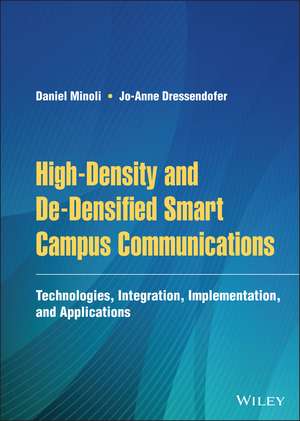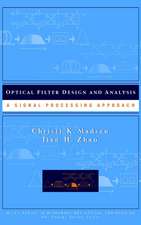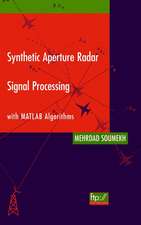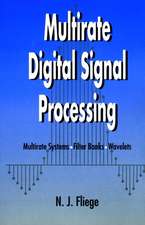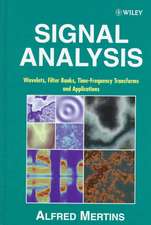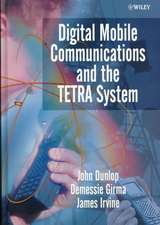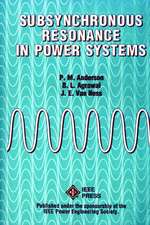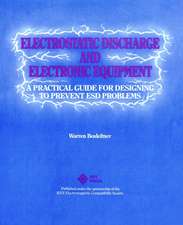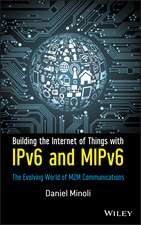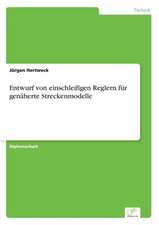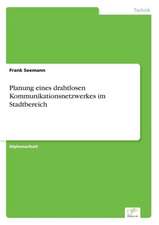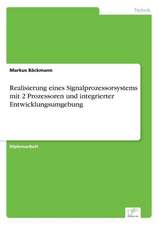High–Density and De–Densified Smart Campus Communications – Technologies, Integration, Implementation and Applications
Autor D Minolien Limba Engleză Hardback – 16 dec 2021
Preț: 762.29 lei
Preț vechi: 837.68 lei
-9% Nou
Puncte Express: 1143
Preț estimativ în valută:
145.87€ • 155.98$ • 121.62£
145.87€ • 155.98$ • 121.62£
Carte tipărită la comandă
Livrare economică 18 aprilie-02 mai
Preluare comenzi: 021 569.72.76
Specificații
ISBN-13: 9781119716051
ISBN-10: 1119716055
Pagini: 368
Dimensiuni: 179 x 264 x 27 mm
Greutate: 0.84 kg
Editura: Wiley
Locul publicării:Hoboken, United States
ISBN-10: 1119716055
Pagini: 368
Dimensiuni: 179 x 264 x 27 mm
Greutate: 0.84 kg
Editura: Wiley
Locul publicării:Hoboken, United States
Cuprins
Preface xi
About The Authors xiii
Acknowledgement xv
1 Background and Functional Requirements for High-Density Communications 1
1.1 Background 1
1.2 Requirements for High-Density Communications 4
1.2.1 Pre-pandemic/Long-term Requirements for Airports 5
1.2.2 Pre-pandemic/Long-term Requirements for Stadiums 7
1.2.3 Pre-pandemic/Long-term Requirements for Convention Centers 7
1.2.4 Pre-pandemic/Long-term Requirements for Open Air Gatherings and Amusement Parks 10
1.2.5 Pre-pandemic/Long-term Requirements for Classrooms 11
1.2.6 Pre-pandemic/Long-term Requirements for Train and Subway Stations 12
1.2.7 Pre-pandemic/Long-term Requirements for Dense Office Environments 12
1.2.8 Ongoing Requirements for Dense Smart Warehouses and Distribution Centers 14
1.2.9 Pre-pandemic/Long-term Requirements for Dense Smart Cities 14
1.3 Pandemic-Driven Social Distancing 16
1.3.1 Best Practices 16
1.3.2 Heuristic Density for the Pandemic Era 20
1.4 The Concept of a Wireless Super Network 20
References 22
2 Traditional WLAN Technologies 26
2.1 Overview 26
2.2 WLAN Standards 28
2.3 WLAN Basic Concepts 29
2.3.1 PHY Layer Operation 32
2.3.2 MAC Layer Operation 36
2.4 Hardware Elements 40
2.5 KEY IEEE 802.11ac Mechanisms 42
2.5.1 Downlink Multi-User MIMO (DL-MU-MIMO) 42
2.5.2 Beamforming 45
2.5.3 Dynamic Frequency Selection 45
2.5.4 Space-Time Block Coding 46
2.5.5 Product Waves 48
2.6 Brief Preview of IEEE 802.11ax 48
References 49
3 Traditional DAS Technologies 51
3.1 Overview 51
3.2 Frequency Bands of Cellular Operation 56
3.2.1 Traditional RF Spectrum 56
3.2.2 Citizens Broadband Radio Service (CBRS) 60
3.2.3 Freed-up Satellite C-Band 62
3.2.4 5G Bands 64
3.2.5 Motivations for Additional Spectrum 65
3.2.6 Private LTE/Private CBRS 66
3.2.7 5G Network Slicing 68
3.2.8 Supportive Technologies 68
3.3 Distributed Antenna Systems (DASs) 70
3.3.1 Technology Scope 70
3.3.2 More Detailed Exemplary Arrangement 76
3.3.3 Traffic-aware DAS 81
3.3.4 BBU and DAS/RRU Connectivity 82
3.3.5 Ethernet/IP Transport Connectivity of DAS 84
References 84
4 Traditional Sensor Networks/IoT Services 87
4.1 Overview and Environment 87
4.2 Architectural Concepts 93
4.3 Wireless Technologies for the IoT 96
4.3.1 Pre-5G Wireless Technologies for the IoT 100
4.3.2 NB-IoT 104
4.3.3 LTE-M 105
4.3.4 5G Technologies for the IoT 106
4.3.5 WAN-Oriented IoT Connectivity Migration Strategies 108
4.4 Examples of Seven-Layer IoT Protocol Stacks 109
4.4.1 UPnP 109
4.4.2 ZigBee 115
4.4.3 Bluetooth 116
4.5 Gateway-Based IoT Operation 117
4.6 Edge Computing in the IoT Ecosystem 118
4.7 Session Establishment Example 121
4.8 IoT Security 121
4.8.1 Challenges 121
4.8.2 Applicable Security Mechanisms 125
4.8.3 Hardware Considerations 127
4.8.4 Other Approaches: Blockchains 132
References 132
5 Evolved Campus Connectivity 139
5.1 Advanced Solutions 140
5.1.1 802.11ax Basics 143
5.1.2 Key 802.11ax Processes 154
5.1.3 Summary 156
5.2 Voice Over Wi-Fi (VoWi-Fi) 158
5.3 5G Technologies 163
5.3.1 Emerging Services 164
5.3.2 New Access and Core Elements 165
5.3.3 New 5GC Architecture 168
5.3.4 Frequency Spectrum and Propagation Challenges 169
5.3.5 Resource Management 170
5.3.6 Requirements for Small Cells 175
5.3.7 Comparison to Wi-Fi 6 178
5.4 IoT 178
5.5 5G DAS Solutions 179
5.6 Integrated Solutions 179
References 181
6 De-densification of Spaces and Work Environments 184
6.1 Overview 184
6.2 Basic Approaches 189
6.3 RTLS Methodologies and Technologies 194
6.3.1 RFID Systems 202
6.3.2 Wi-Fi-based Positioning System (WPS) 205
6.3.3 Bluetooth 206
6.3.4 UWB 207
6.3.5 Automatic Vehicle Location (AVL) 207
6.4 Standards 207
6.5 Applications 209
References 212
7 UWB-Based De-densification of Spaces and Work Environments 222
7.1 Review of UWB Technology 223
7.2 Carriage of Information in UWB 226
7.2.1 Pulse Communication 226
7.2.2 UWB Modulation 228
7.3 UWB Standards 232
7.4 IoT Applications for UWB 237
7.5 UWB Applications for Smart Cities and for Real-Time Locating Systems 239
7.5.1 Applications for Smart Cities 239
7.5.2 UWB Applications to Real-Time Location Systems 240
7.6 OSD/ODCMA Applications 248
References 253
8 RTLSs and Distance Tracking Using Wi-Fi, Bluetooth, and Cellular Technologies 258
8.1 Overview 258
8.2 RF Fingerprinting Methods 260
8.3 Wi-Fi RTLS Approaches 261
8.3.1 Common Approach 261
8.3.2 Design Considerations 266
8.3.3 Drawbacks and Limitations 267
8.3.4 Potential Enhancements 267
8.3.5 Illustrative Examples 269
8.4 BLE 271
8.4.1 Bluetooth and BLE Background 271
8.4.2 RTLS Applications 273
8.4.3 BLE-Based Contact Tracing 278
8.4.4 Illustrative Examples 280
8.5 Cellular Approaches 283
8.6 Summary 286
References 288
9 Case Study of an Implementation and Rollout of a High-Density High-Impact Network 291
9.1 Thurgood Marshall BWI Airport Design Requirements 292
9.1.1 Broad Motivation 293
9.1.2 Status Quo Challenges 294
9.1.3 RFP Requirements 295
9.2 Overview of the Final Design 298
9.2.1 DAS Solutions 300
9.2.2 Broadband, BLE, IoT 305
10 The Age of Wi-Fi and Rise of the Wireless SuperNetwork (WiSNET)TM 312
10.1 What Preceded the WiSNET 312
10.2 What Comes Next 313
10.3 The Super-Integration Concept of a Wireless SuperNetwork (WiSNET) 314
10.4 The Multidimensionality of a SuperNetwork (WiSNET) 317
10.5 The Genesis of the WiSNET Concept Defined in this Text 317
10.6 The Definition and Characterization of a WiSNET 320
10.6.1 Architectural Aspects of a WiSNET 321
10.6.2 Technology Aspects of a WiSNET 325
10.6.3 Management Aspects of a WiSNET 328
10.7 Economic Advantages of a WiSNET System 331
10.8 5G Slice Capabilities 332
10.8.1 Motivations and Approaches for 5G Network Slicing 332
10.8.2 Implementation 335
10.8.3 Wi-Fi Slicing 335
10.9 Conclusion 335
References 336
Index 337
